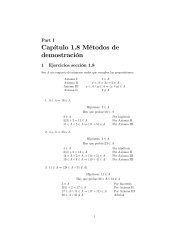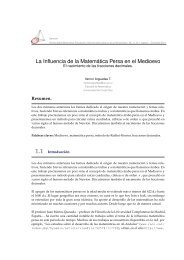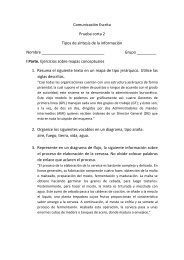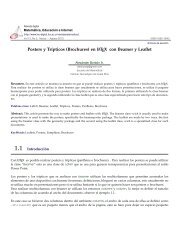Derivada de una función - TEC-Digital
Derivada de una función - TEC-Digital
Derivada de una función - TEC-Digital
Create successful ePaper yourself
Turn your PDF publications into a flip-book with our unique Google optimized e-Paper software.
Ejercicios.<br />
Determine f ′ (x) si<br />
csc x2<br />
a. f(x) = e<br />
b. f(x) = 3√ csc x<br />
2 x<br />
c. f(x) = cot , x = −1<br />
x + 1<br />
2.1.12 <strong>Derivada</strong>s <strong>de</strong> las funciones inversas<br />
<strong>Derivada</strong>s <strong>de</strong> las funciones inversas 43<br />
Previo al estudio <strong>de</strong> las funciones trigonométricas inversas, es necesario <strong>de</strong>terminar la <strong>de</strong>rivada <strong>de</strong> la <strong>función</strong><br />
inversa <strong>de</strong> <strong>una</strong> <strong>función</strong> dada. Para ello consi<strong>de</strong>remos el siguiente teorema.<br />
Teorema 1<br />
Sea f <strong>una</strong> <strong>función</strong> estrictamente creciente y continua en un intervalo [a, b] y g la <strong>función</strong> inversa <strong>de</strong> f.<br />
Si f ′ (x) existe y es diferente <strong>de</strong> cero para x ∈]a, b[, entonces la <strong>función</strong> <strong>de</strong>rivada g ′ (y) también existe y no es<br />
nula en el correspondiente “y” don<strong>de</strong> y = f(x).<br />
A<strong>de</strong>más se tiene que g ′ (y) = 1<br />
f ′ (x) , o sea Dyg(y) =<br />
1<br />
Dxf(x) .<br />
Note que si y = f(x) entonces x = g(y) correspon<strong>de</strong> a f −1 (y), y Dyf −1 (y) = 1<br />
Dxy<br />
Demostración: Al final <strong>de</strong>l capítulo<br />
Ejemplo 1<br />
Consi<strong>de</strong>remos la <strong>función</strong> <strong>de</strong>finida por:<br />
f : ]0, +∞[−→] − 3, +∞[, f(x) = y = x 2 − 3<br />
Esta <strong>función</strong> posee <strong>función</strong> inversa <strong>de</strong>finida por:<br />
g : ] − 3, +∞[−→]0, +∞[, g(y) = √ y + 3<br />
Se tiene que g ′ (y) =<br />
Como<br />
1<br />
2 √ y + 3<br />
y = x 2 + 3 entonces g ′ (y) =<br />
g ′ (x) =<br />
1<br />
Dx(x2 1<br />
=<br />
− 3) f ′ (x)<br />
1<br />
2 √ x 2 − 3 + 3<br />
Note que: √ x 2 = |x| = x pues x ∈]0, +∞[<br />
1<br />
=<br />
2 √ 1<br />
=<br />
x2 2x

















